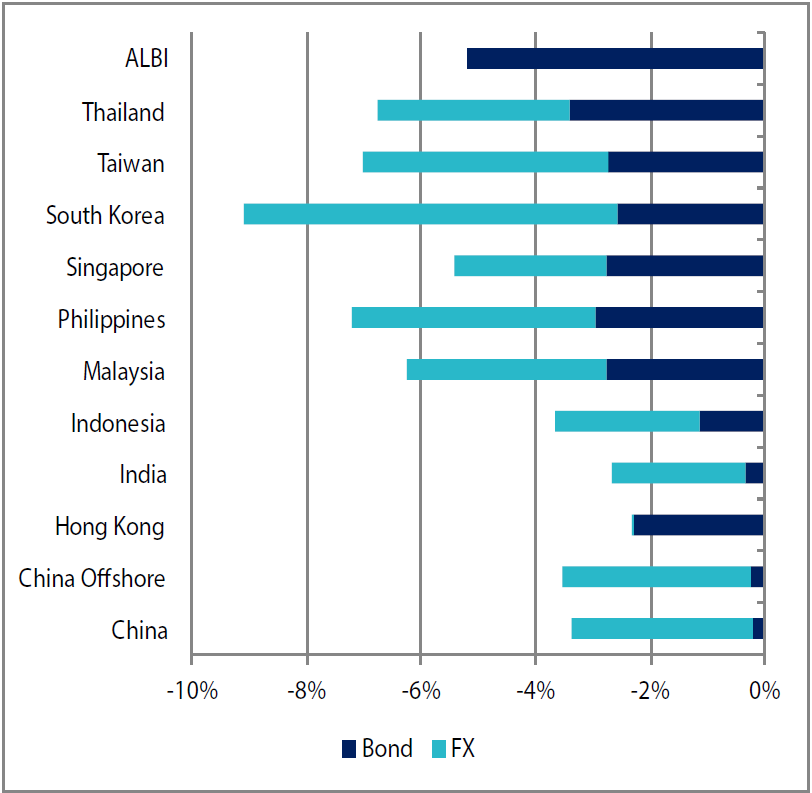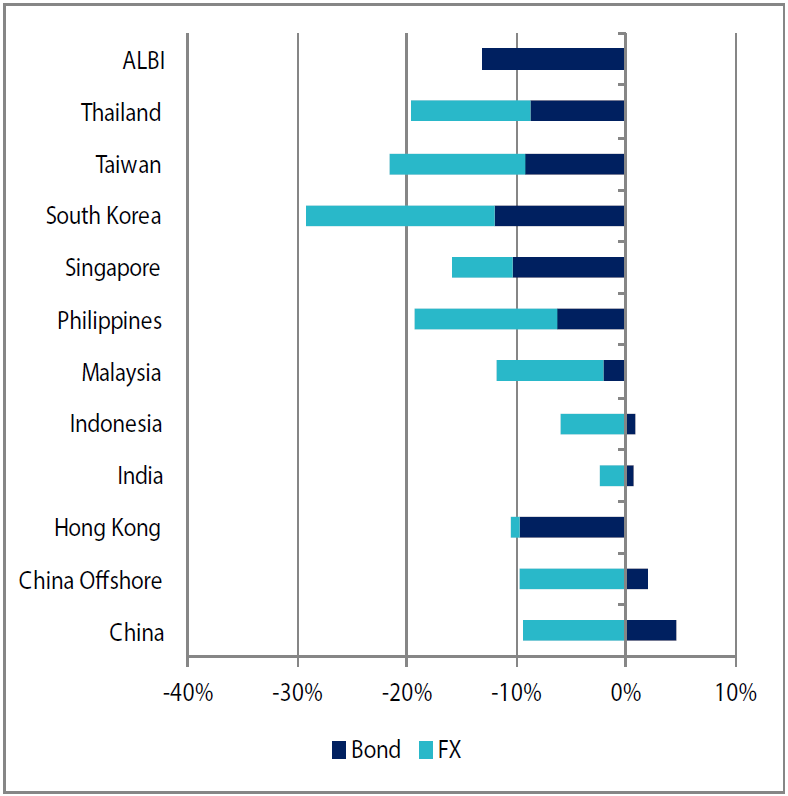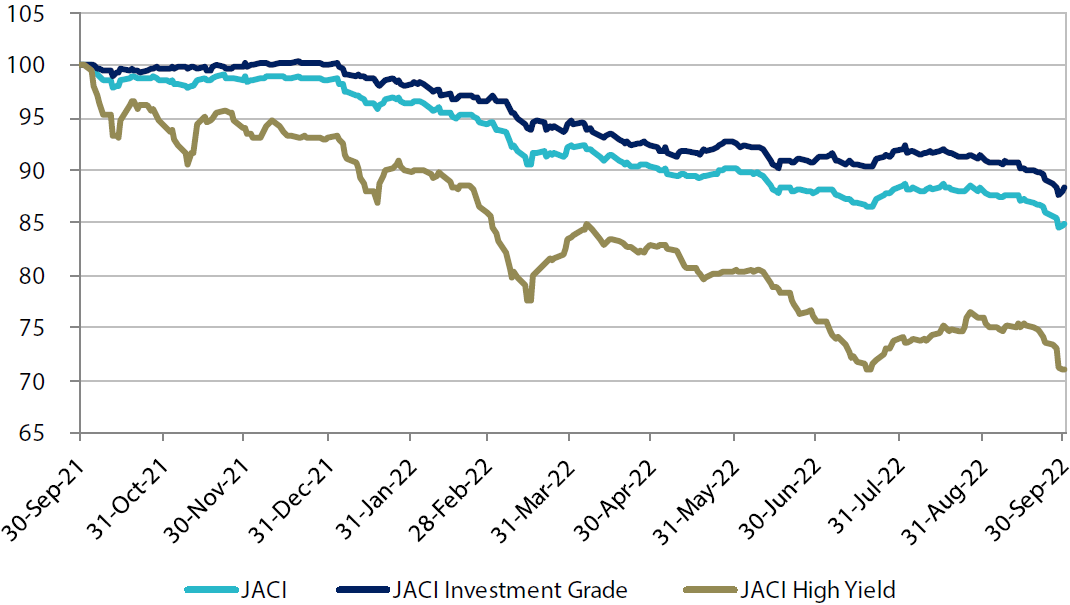Summary
- US Treasury (UST) yields rose in September, with the benchmark 2-year and 10-year UST yields ending at 4.281% and 3.832% respectively, 78.6 basis points (bps) and 63.7 bps higher compared to end-August.
- Inflationary pressures for the region generally remained elevated in August. During the month, central banks in Malaysia, Thailand, India, Indonesia and the Philippines raised their key policy rates. Monetary authorities in the Philippines, Indonesia and Thailand revised their inflation forecasts higher.
- The People’s Bank of China (PBOC) announced measures in a bid to address further weakening of the renminbi (RMB) and warned against speculation on RMB. Chinese banks lower their benchmark deposit rates. The authorities also unveiled more moves to support the real estate sector.
- We prefer Indonesia government bonds; compared to regional peers, they are likely to be better supported on the back of flush domestic liquidity and a relatively attractive real yield.
- Asian credits retreated 3.51% in total return as credit spreads widened about 25 bps amid a sharp rise in UST yields. Asian high-grade (HG) declined 2.98%, outperforming Asian high-yield (HY), which fell 6.35%.
- Going forward, despite some expected moderation amidst the slowdown in global growth, we believe that growth and corporate credit fundamentals will remain sufficiently robust to prevent a meaningful widening of credit spreads. However, some modest widening may be expected in the near term, with the benchmark spread level at the tighter end of the expected medium-term range and given the plethora of global market risks.
Asian rates and FX
Market review
UST yields surge in September
UST yields pushed higher anew in September, with the yield curve inverting more as short to mid-dated Treasury bonds underperformed. The month opened to the market continuing to unwind expectations for an early pivot by the US Federal Reserve (Fed) post the Jackson Hole Symposium. Weakness in Treasuries was exacerbated thereafter by better-than-expected US labour and consumer price index (CPI) reports for August that cemented another sizable move in the Fed Funds Rate in September and raised expectations for a higher terminal rate. There was a significant rise in front-end yields following the Federal Open market Committee (FOMC) meeting. Although the 75-bps increase was largely expected by markets, upward revisions to the policy rate and unemployment rate projections, together with downward revisions to growth estimates, signalled that the Fed would likely embark on a more protracted and/or aggressive monetary tightening cycle to combat rising inflation. Further, Fed Chairman Jerome Powell’s acknowledgment that some economic pain might be necessary to curb inflation, rattled markets. Toward month-end, risk sentiment turned decisively bearish as markets focused on events unfolding in the UK. Gilt yields surged and the British pound hit an all-time low against the US dollar (USD) on concerns over the UK government’s medium-term fiscal sustainability after the new administration unveiled its growth plan which included extensive tax cuts. The ensuing market turmoil triggered an intervention by the Bank of England, pushing global yields to partially retrace the earlier rise. At the end of the period, the benchmark 2-year and 10-year UST yields were at 4.281% and 3.832% respectively, 78.6 bps and 63.7 bps higher compared to end-August.
Chart 1: Markit iBoxx Asian Local Bond Index (ALBI)
| For the month ending 30 September 2022 | For one year ending 30 September 2022 | |

|

|
Source: Markit iBoxx Asian Local Currency Bond Indices, Bloomberg, 30 September 2022
Note: Bond returns refer to ALBI indices quoted in local currencies while FX refers to local currency movement against USD. ALBI regional index is in USD unhedged terms. Returns are based on historical prices. Past performance is not necessarily indicative of future performance.
Core CPI prints accelerate in August
Core CPI inflation prints in the region accelerated in August. The Monetary Authority of Singapore’s preferred core inflation measure, which excludes private transport and accommodation inflation, picked up further as food and services inflation continued to increase. The 5.1% year-on-year (YoY) print marks its highest level since end-2008. Meanwhile, although overall inflation moderated in the Philippines, core inflation—which strips out volatile food and energy costs—increased to 4.6% YoY in August from 3.9% YoY in July. Similarly, while Indonesia’s headline CPI reading eased in August, its core inflation inched up to 3.04% YoY from 2.86% YoY in July. Elsewhere, Thailand’s core CPI—which excludes raw food and energy prices—increased to 3.15% YoY in August from 2.99% YoY in July.
Central banks in Malaysia, Thailand, India, Indonesia and the Philippines raise their key policy rates
In response to accelerating inflationary pressures, monetary authorities in the region raised their policy rates anew. Monetary authorities in Malaysia and Thailand hiked interest rates by 25 bps each, with both central banks reiterating a “gradual and measured” policy approach moving forward. Meanwhile, Bank Indonesia (BI) raised its policy rate by 50 bps, declaring that the move is a” front-loaded, pre-emptive and forward-looking” step to lower inflation expectations and support BI’s foreign exchange (FX) stabilization policy amid stronger domestic demand. The Reserve Bank of India and Bangko Sentral ng Pilipinas (BSP) similarly hiked interest rates by 50 bps each, with the BSP noting that “price pressures continue to broaden.”
Monetary authorities revise their inflation forecasts higher
Citing higher global non-oil prices, pending petitions for further transport fare increases as well as the sharp increase in sugar prices, BSP raised its headline inflation forecasts to 5.6% from 5.4% this year and to 4.1% from 4.0% for 2023. According to the BSP, inflationary pressures could ease to within its 2% to 4 % target range by the second half of 2023. In Indonesia, BI Governor Perry Warjiyo said the central bank now expects end-2022 headline inflation to register slightly above 6% (from 5.9%). The Bank of Thailand also raised its headline inflation forecast, to 6.3% (from 6.2%) in 2022 and to 2.6% (from 2.5%) in 2023. It expects headline inflation to gradually ease from here on and return to within its target range in the second quarter of 2023.
PBOC moves to address downward pressure on the RMB
The Chinese central bank eased the reserve requirement ratio (RRR) for FX deposits by 200 bps to 6% from 8%, effective 15 September. Subsequently, it reimposed the 20% risk reserve ratio on banks’ currency forward sales, thereby making the shorting of the Chinese renminbi (RMB) more costly. Towards month-end, the PBOC gave a strongly worded verbal warning against currency speculation.
Chinese banks lower benchmark deposit rates; policymakers step up support for the property sector
China’s biggest banks lowered their benchmark deposit rates across the board for the first time since 2015–in a move to boost lending and support growth. Separately, authorities unveiled additional measures to support the real estate sector. Among these measures, the city of Guangzhou reportedly adjusted the price cap and floor for properties to allow greater flexibility for developers seeking to destock their inventory. Also, authorities allowed select local governments to further relax the lower limit on mortgage rates for first-time homebuyers and announced a rare tax incentive for select homebuyers. Moreover, regulators reportedly told the largest state-owned banks to extend at least CNY 600 billion of net financing to the property sector in the final four months of the year.
Indonesia raises oil prices; Singapore announces property cooling measures
During the month, the Indonesian government finally raised the price of its subsidized gasoline to ease the weight off the state budget and keep its fiscal deficit under control. Meanwhile, policymakers in Singapore announced property cooling measures which included tightening the maximum loan quantum limit and lowering the loan-to-value limit for public housing loans.
Market outlook
Prefer Indonesia bonds
Recent rhetoric from various Fed officials including the chairman suggests the central bank is set to pursue further rate hikes in the coming months. In Asia, with inflation remaining above the upper tolerance of most central banks, further monetary policy tightening—albeit in varying degrees—is also likely in the near term. This means that the outlook for growth now looks increasingly weaker into 2023, which should provide some support for bond yields. That said, we are cognizant that the current global economic backdrop is full of uncertainty. However, with 10-year UST yields close to 4%, we believe that risk-reward in fixed income has become more favourable. Against regional peers, Indonesia government bonds are likely to be better supported on the back of flush domestic liquidity and relatively attractive real yield.
Asian credits
Market review
Asian credits end lower as spreads widen and US Treasury (UST) yields rise
Asian credits returned -3.51% in September, as spreads widened about 25 basis points (bps) and UST yields adjusted sharply higher. Asian High-Grade (HG) credits performed better than Asian High-Yield (HY), the former declining 2.98%, with spreads widening about 10 bps. Asian HY credit retreated 6.35%, with spreads widening 150 bps.
The month opened to markets continuing to unwind expectations for an early pivot by the US Federal Reserve (Fed) post the Jackson Hole Symposium, prompting Asian credit spreads to drift higher. However, the rise in spreads was short-lived as risk sentiment—particularly towards the Chinese property sector—quickly improved following unofficial reports that authorities intend to significantly relax measures to arrest the property slump. Demand for the sector was further buoyed by subsequent news that select cities had allowed property developers to provide bigger reductions in home prices. Meanwhile, sentiment towards some other Asian markets was lifted by further economic reopening. Hong Kong declared an end to the city’s mandatory hotel quarantine, while Macau announced the resumption of the e-visa program and group tours. There was a reversal in overall risk tone heading into month-end. Further monetary policy tightening by major central banks, rising global bond yields and escalation in the Russia-Ukraine war eventually prompted credit spreads to reverse higher. Risk assets including Asian credits extended losses following extreme volatility in the UK gilt market after the new UK government unveiled plans for extensive tax cuts to boost growth. This notwithstanding, Chinese property credits received a last-minute boost after regulators stepped up support for the sector (including further relaxation of the lower limit on mortgage rates for select first-time homebuyers and a rare tax incentive for some homebuyers). However this was offset in part by concerns surrounding missed payments by a property developer which had recently issued a state-guaranteed bond. Overall, all major country-segments in Asia, save for South Korea, saw credit spreads widen in the month.
Primary market activity slightly picks up in September
The month saw a slight pick-up in primary market activity, with a total of 31 new issues. The HG space saw 16 new issues amounting to USD 7.5 billion, including the USD 2.5-billion three-tranche issue from Export-Import Bank Korea and USD 2.65-billion three-tranche sovereign issue from Indonesia. Meanwhile, the HY space saw 15 new issues amounting to about USD 2.36 billion.
Chart 2: JP Morgan Asia Credit Index (JACI)
Index rebased to 100 at 30 September 2021

Note: Returns in USD. Past performance is not necessarily indicative of future performance.
Source: Bloomberg, 30 September 2022
Market outlook
Expect moderation to fundamentals but adequate cushion to prevent meaningful spread widening
The firmer-than-expected US August CPI data and the strong signals by the Fed that policy would need to be tightened further caused a significant repricing of the Fed Funds terminal rate and front-end UST yields. We believe that current yield levels have already reflect much of these hawkish surprises, although heightened volatility is likely to persist with various global market developments and economic data exerting opposing pressures.
Despite some expected moderation amidst the slowdown in global growth, we believe the macro and corporate credit fundamentals across much of Asia will remain robust enough to prevent meaningful credit spread widening. However, with the benchmark spread level at the tighter end of the expected medium-term range, and given the plethora of global market risks, there is some scope for modest widening for the near term. Meanwhile, China growth risks remain towards the downside with lingering concerns surrounding the real estate sector and duration of China’s zero-COVID policy. Although the Chinese policymakers announced more supportive measures for the property sector towards late September, a sustained physical market recovery will take time. The 20th Congress of the Chinese Communist Party in mid-October will be closely watched for leadership changes and signs of any major policy shifts.






